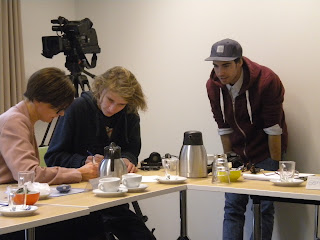I was very pleased to be invited to address the Board and senior managers of United Medical Center in Washington, DC, earlier this week. UMC is located in the Southeast section of the city. It is the safety net hospital for indigent people and serves a population with a variety of complex and difficult conditions, including hypertension, diabetes, and HIV/AIDS. The hospital is facing severe financial challenges as a result of changes in Medicaid and Medicare payment regimes, and there are also interesting questions of ownership and governance that will need to be resolved over the coming years if it is to carry out the community mission which is so essential.
I was not surprised to meet a dedicated group of Board members and staff people. One of those was Dr. Lisa Fitzpatrick, an infectious disease specialist, who has created a multidisciplinary clinic to help HIV/AIDS patients. On the occasion of World AIDS Day tomorrow, Lisa has published an article in the Huffington Post entitled, " Getting to Zero AIDS Cases in America -- Can We Do It?" She notes:
No one should ever die of AIDS. Unfortunately, many people arrive at my office for their first visit because they have become sick or begun to show symptoms of HIV. A few have even waited until it was too late and died of HIV. What kept most of these people out of my office is the shame and embarrassment of contracting HIV. This shouldn't be. HIV is a preventable and treatable disease. It is certainly within our power to address this public health scourge. We can do it. But we must become educated about the disease, its prevention and treatment.
It would be a shame if one of the unintended consequences of Obamacare is a change in funding to safety net hospitals that removes some of their ability to carry out the functions Dr. Fitzpatrick has eloquently set forward. Maybe UMC--an important component of the District of Columbia health system--can help send that message to Congress over the coming months. On this matter, the Board and the medical staff should be united, along with other safety net hospitals throughout the country.
I was not surprised to meet a dedicated group of Board members and staff people. One of those was Dr. Lisa Fitzpatrick, an infectious disease specialist, who has created a multidisciplinary clinic to help HIV/AIDS patients. On the occasion of World AIDS Day tomorrow, Lisa has published an article in the Huffington Post entitled, " Getting to Zero AIDS Cases in America -- Can We Do It?" She notes:
No one should ever die of AIDS. Unfortunately, many people arrive at my office for their first visit because they have become sick or begun to show symptoms of HIV. A few have even waited until it was too late and died of HIV. What kept most of these people out of my office is the shame and embarrassment of contracting HIV. This shouldn't be. HIV is a preventable and treatable disease. It is certainly within our power to address this public health scourge. We can do it. But we must become educated about the disease, its prevention and treatment.
It would be a shame if one of the unintended consequences of Obamacare is a change in funding to safety net hospitals that removes some of their ability to carry out the functions Dr. Fitzpatrick has eloquently set forward. Maybe UMC--an important component of the District of Columbia health system--can help send that message to Congress over the coming months. On this matter, the Board and the medical staff should be united, along with other safety net hospitals throughout the country.











































